Learning Agents In Artificial Intelligence
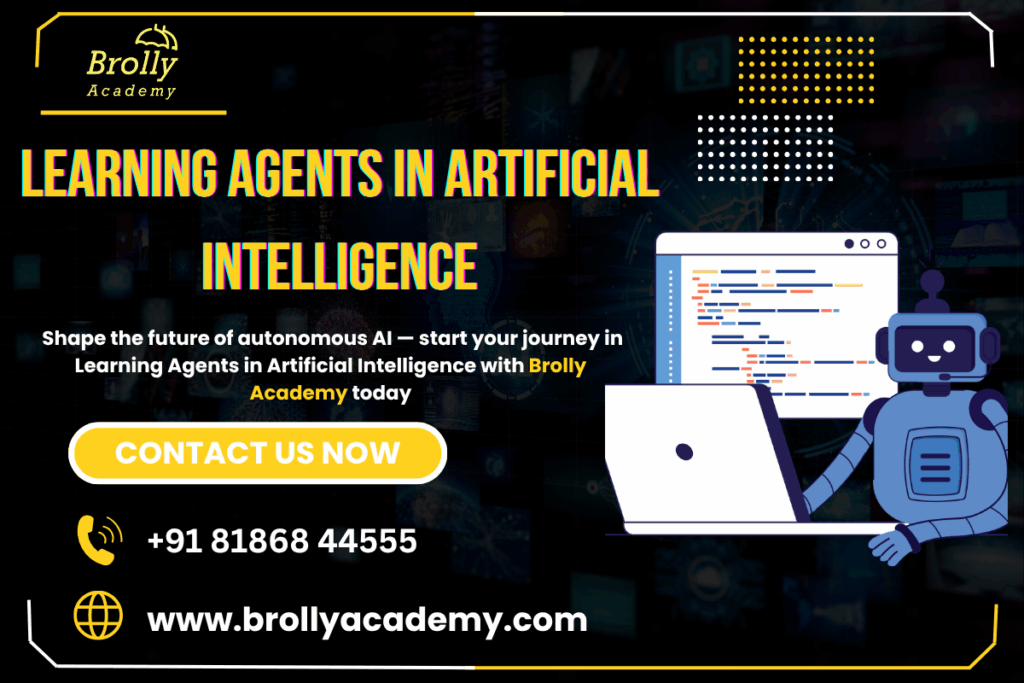
Table of Contents
ToggleIntroduction Of Learning Agents In Artificial Intelligence
- Learning Agents in Artificial Intelligence are intelligent systems that can learn from experience, adapt to changing environments, and improve their performance over time.
- They form the foundation of modern AI technologies, enabling machines to make smarter decisions without constant human supervision.
- From self-driving cars and virtual assistants to personalized recommendations on Netflix or Amazon, learning agents are driving real-world innovation across industries.
Keypoint:
- Discover how learning agents are transforming the future of AI — powering automation, decision-making, and intelligent systems worldwide.

Overview Of Learning Agents In Artificial Intelligence
- In 2025, learning agents in artificial intelligence are driving the evolution of AI learning models and intelligent agents across multiple industries.
- These adaptive AI systems can perceive their environment, analyze data, and learn from feedback to make smarter, autonomous decisions.
- Unlike traditional rule-based systems, learning agents continuously refine their performance through experience — making them essential for achieving efficiency and automation at scale.
- They play a vital role in healthcare, where AI models assist in early disease detection and personalized treatments; in robotics, where agents enable autonomous movement and decision-making; and in industrial automation, where smart systems optimize workflows and predictive maintenance.
- As we move further into 2025, learning agents stand at the core of modern AI innovation, powering real-time intelligence, adaptability, and continuous learning across industries.
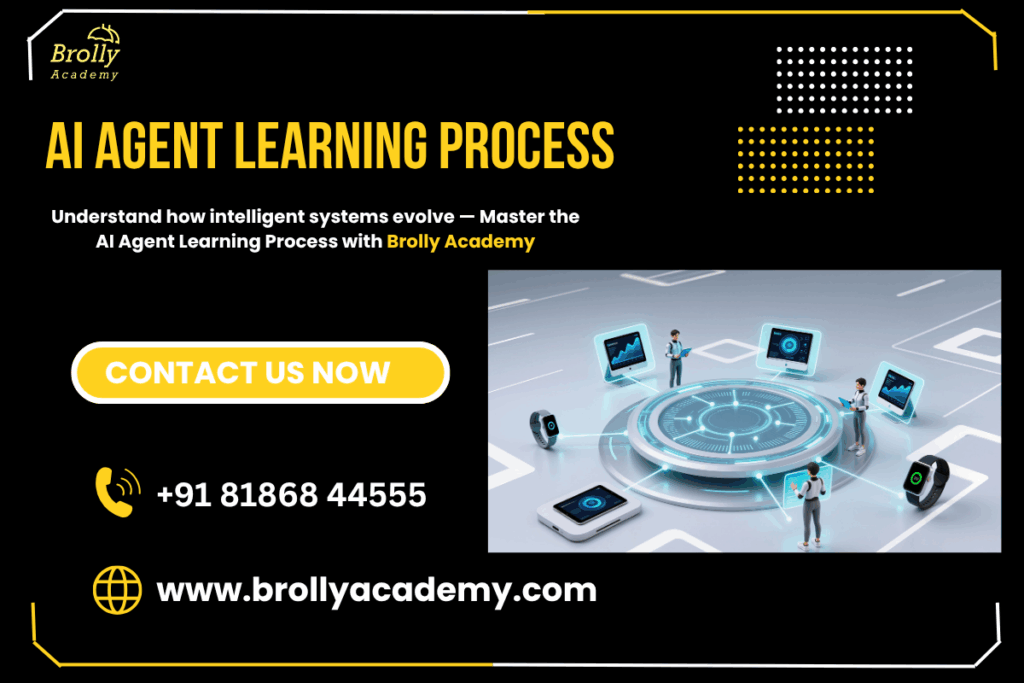
What is a Learning Agent in AI?
Definition:
- A learning agent in artificial intelligence is an intelligent program or adaptive AI system that can learn from experience, adapt to changes, and improve its decision-making over time.
- Instead of relying solely on fixed instructions, it uses self-learning algorithms to analyze data, receive feedback, and refine its actions for better outcomes.
- These cognitive agents can operate autonomously, continuously enhancing their performance in dynamic environments.
- Unlike static agents that follow predefined rules, learning agents evolve through experience, making them more flexible and capable of handling real-world complexity.
Difference Between Static Agents and Learning Agents
Aspect | Static Agents | Learning Agents |
Adaptability | Follow fixed rules; no change over time | Continuously adapt using self-learning algorithms |
Learning Ability | No learning capability | Learn from data and feedback |
Decision-Making | Based on predefined logic | Based on experience and evolving strategies |
Flexibility | Limited to specific tasks | Highly flexible and dynamic |
Example | Basic thermostat system | Self-driving car that improves with every trip |
Example:
A self-driving car is a perfect example of a learning agent — it uses sensors and AI learning models to observe surroundings, learn from past experiences, and make safe, intelligent driving decisions.
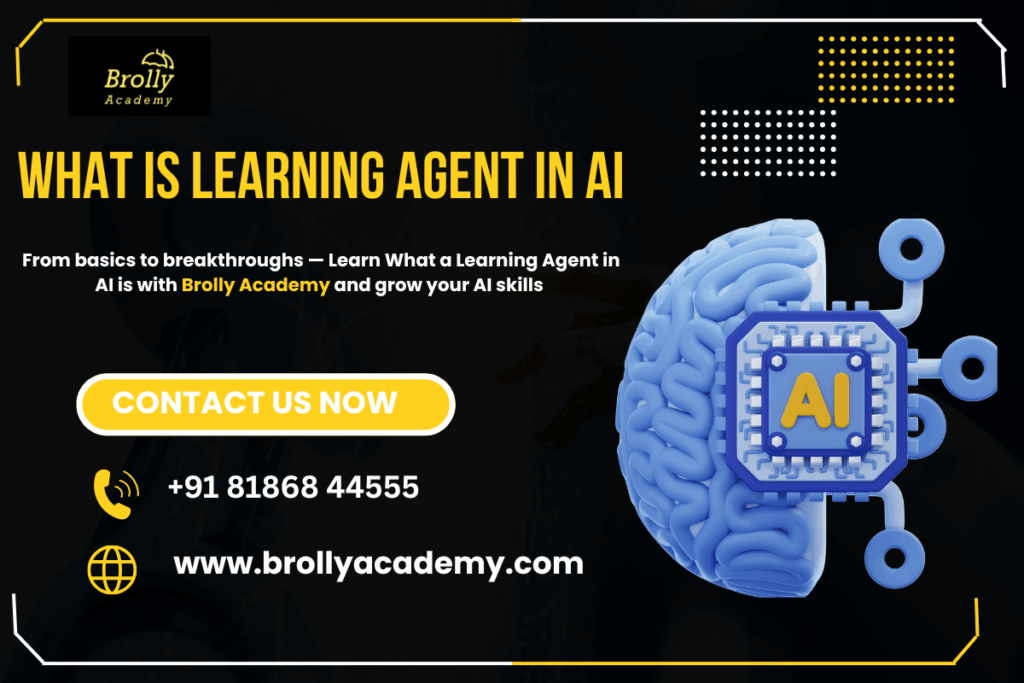
How Does a Learning Agent Work in Artificial Intelligence?
- A learning agent in artificial intelligence works by observing its environment, learning from feedback, and improving decisions through self-learning algorithms.
- It forms the core of adaptive AI systems, where it gathers data, analyzes outcomes, and refines its actions for better performance.
- These cognitive agents use AI learning models that include key components — the learning element, performance element, critic, and problem generator — to evaluate experiences and adapt intelligently.
- In practice, such intelligent agents power technologies like self-driving cars, chatbots, and robotics, enabling automation and smart decision-making across industries.
Step 1: The Performance Element Takes Action
- The performance element is the active part of AI agents responsible for executing actions in the real world.
- It applies the knowledge and strategies gained from previous learning to make informed decisions.
- Using trained AI learning models, the performance element observes the current environment, selects the best possible action, and implements it to achieve a specific goal.
- In simple terms, it acts as the “decision executor” of an AI agent — transforming learned experiences into real-time performance.
- For example, in a self-driving car, the performance element decides when to accelerate, brake, or turn based on sensor data and past learning patterns.
Step 2: The Critic Gives Feedback
- The critic in a learning agent acts as the AI feedback mechanism that evaluates how well the performance element’s actions achieved the desired outcome.
- It compares the agent’s results with the expected goals and provides feedback on whether the decision was effective or needs improvement.
- This AI feedback mechanism helps the agent identify mistakes, measure performance accuracy, and guide future learning.
- By assessing outcomes and generating performance scores, the critic ensures that the learning process remains adaptive and efficient.
Step 3: The Learning Element Updates the Agent
- The learning element is responsible for improving the agent’s performance by using feedback received from the critic.
- It applies the reinforcement learning process to analyze which actions led to positive or negative results and adjusts future strategies accordingly.
- Through this continual learning cycle, the agent refines its decision-making ability, strengthens successful behaviors, and minimizes errors.
- The reinforcement learning process ensures that every experience contributes to smarter, data-driven actions — allowing the AI system to become more accurate, efficient, and adaptive over time.
Step 4: The Problem Generator Suggests New Things to Try
- The problem generator plays a vital role in enhancing an AI agent’s intelligence by introducing exploration — the process of trying new strategies or actions to discover better outcomes.
- It ensures the system doesn’t rely solely on past knowledge but continuously seeks improvement through experimentation.
- By promoting adaptive decision-making, the problem generator helps the agent evaluate multiple possibilities and learn from varied experiences.
- This leads to continuous AI learning, where the system evolves dynamically, adapts to changing environments, and uncovers innovative ways to solve complex problems.
Example: Netflix or Amazon recommendation system improving through feedback loops.
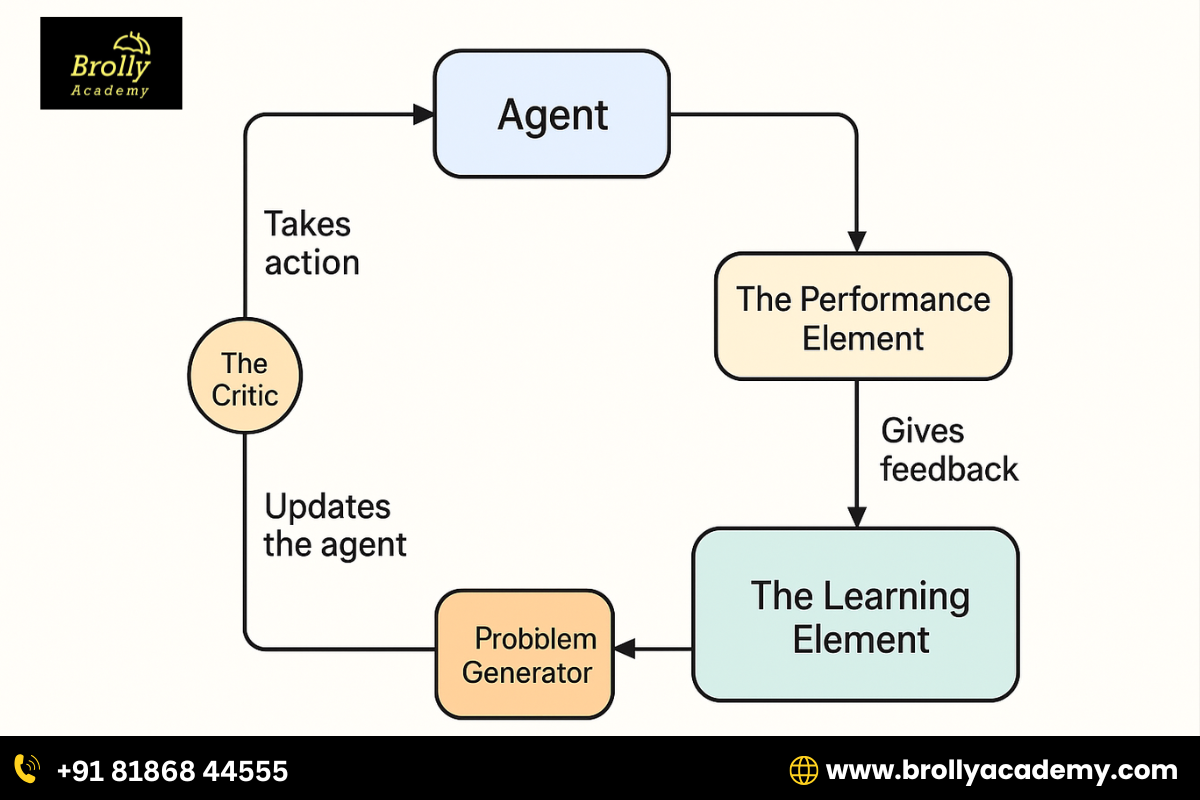
Components of a Learning Agent
- A learning agent is built from several essential parts that work together to make intelligent decisions and improve over time.
- These AI learning components enable the agent to sense its environment, evaluate its actions, and adapt through feedback and exploration. Let’s explore each of these components in a simple and user-friendly way:
Component | Function | Example |
Learning Element | The heart of the agent — it helps the system improve its model using new data. This element identifies patterns, updates algorithms, and fine-tunes decisions based on experiences. | Example: ChatGPT continuously improving its tone and accuracy through user interactions. |
Critic | Acts as the performance evaluation in AI, measuring how well the agent performed after each task. It compares results with desired goals and provides feedback for improvement. | Example: A spam filter assessing the accuracy of classifying emails as spam or not. |
Performance Element | This is where the action happens — it executes tasks based on the knowledge and decisions learned from previous experiences. It interacts directly with the environment to achieve goals. | Example: A self-driving car navigating roads safely by applying learned driving behaviors. |
Problem Generator | Encourages innovation and creativity by suggesting new approaches or unexplored actions. It ensures the agent doesn’t get stuck doing the same thing and continues learning from new possibilities. | Example: AI in gaming developing new strategies to defeat human players through trial and error. |
- Together, these problem-solving agents create a cycle of learning, feedback, and adaptation. The learning element updates knowledge, the critic evaluates, the performance element acts, and the problem generator explores — forming a powerful, intelligent system capable of continuous improvement.
- This harmonious collaboration of AI learning components is what makes modern adaptive AI systems so effective across industries like robotics, automation, and digital assistants.
Types of Learning in AI Learning Agents
- Learning agents in artificial intelligence use different AI learning models to acquire knowledge and enhance performance.
- These models define how an agent gathers, processes, and improves its understanding from experience.
- Each learning type serves a unique purpose, from recognizing labeled patterns to discovering new insights autonomously.
- Below are the main types of learning in AI learning agents, explained in a user-friendly and SEO-optimized manner.
Supervised Learning
- Supervised learning in AI is one of the most common types, where the agent learns from labeled data — data that already contains correct answers.
- The system analyzes input-output pairs and gradually learns to map new inputs to accurate outputs.
- For example, a spam filter is trained with thousands of labeled emails — “spam” or “not spam” — and learns to recognize future emails based on those labels.
- Over time, the learning agent improves accuracy by comparing predictions against real outcomes.
- This type of learning is especially useful in image recognition, voice classification, and email filtering, where clear data labels are available to guide training.
Unsupervised Learning
- In unsupervised learning, the agent works without predefined labels. Instead, it observes data to find hidden patterns and relationships on its own.
- This approach allows AI learning agents to identify structure within complex datasets.
- For instance, in market segmentation, an AI model groups customers based on behavior or preferences without any prior labeling.
- Similarly, in anomaly detection, the agent identifies unusual patterns that may indicate fraud or errors.
- Unsupervised learning is vital for pattern discovery, data compression, and recommendation systems, where unlabeled data dominates.
Reinforcement Learning
- Reinforcement learning is a powerful method where the agent learns through trial and error, receiving rewards for good actions and penalties for poor ones.
- This feedback-driven approach mimics human learning behavior.
- A great example is AlphaGo, which learned to play the game of Go by playing millions of rounds against itself and optimizing its strategy.
- Similarly, robotics systems use reinforcement learning to improve navigation, movement, and decision-making.
- These reinforcement learning examples demonstrate how adaptive AI systems evolve autonomously, mastering complex tasks over time through continuous feedback.
Continuous Learning
- Continuous learning allows AI learning agents to adapt and grow even after deployment.
- Instead of static training, these systems process real-time data to keep improving performance in changing environments.
- For example, Tesla’s Autopilot continually learns from data collected from its entire fleet of cars.
- Each driving experience enhances the AI’s ability to handle new roads, weather conditions, and unexpected obstacles.
- This approach makes continuous learning AI crucial for dynamic, fast-evolving domains such as autonomous vehicles, finance, and healthcare, where new data constantly emerges.
Multi-Agent Learning
- Multi-agent learning systems involve multiple AI agents working together in a shared environment to achieve common or individual goals.
- Unlike single-agent models, these systems emphasize collaboration, communication, and coordination, allowing agents to learn from both their own experiences and interactions with others.
- This approach is widely used in swarm robotics, where groups of robots work collectively to perform complex tasks like exploration, rescue operations, or logistics management.
- By enabling cooperative and adaptive decision-making, multi-agent learning enhances scalability, flexibility, and efficiency — making it a cornerstone of next-generation adaptive AI systems.

Feedback Mechanisms in AI Agents
- Feedback is the foundation of how AI agents learn and improve over time. It allows them to evaluate actions, adjust models, and enhance decision-making accuracy.
- These AI feedback loops vary depending on the learning type — from label-based corrections to complex reinforcement learning feedback systems.
- The table below summarizes the main feedback mechanisms used in modern adaptive models:
Learning Type | Feedback Method | Description | Example |
Supervised Learning | Label-based correction | The agent learns by comparing predictions with correct labeled data, improving accuracy through direct feedback. | Email filters detecting spam using labeled examples. |
Unsupervised Learning | Clustering feedback | Feedback arises from pattern recognition or grouping similarities without labeled data, enhancing pattern discovery. | E-commerce segmentation grouping customers by behavior. |
Reinforcement Learning | Reward signals | The agent receives rewards or penalties based on its actions, refining decisions through trial and error. | Game AI improving strategies via reinforcement learning feedback. |
Self-Supervised Learning | Data structure feedback | The system generates its own feedback by predicting parts of data from other parts, leading to deeper contextual understanding. | GPT models learning from vast text patterns for language understanding. |
- These AI feedback loops ensure continuous performance optimization, helping adaptive models evolve intelligently across real-world applications such as robotics, recommendation systems, and natural language processing.
Learning Agents vs Other AI Agent Types
- In artificial intelligence, not all agents learn or adapt in the same way. Some follow fixed rules, while others evolve through experience.
- Understanding the difference between reactive agents, goal-based agents, and learning agents helps explain how intelligent systems progress from simple automation to adaptive intelligence.
The table below provides a clear comparison:
Agent Type | Learning Ability | Description | Real-World Example |
Reactive Agents | No | These agents respond directly to environmental stimuli without memory or learning. They operate on pre-defined rules and can’t adapt to new situations. They are fast but limited in flexibility. | Obstacle-avoiding robots that change direction when sensing an obstacle but don’t learn from past encounters. |
Goal-Based Agents | Partial | These intelligent systems act to achieve specific goals. They evaluate possible actions and choose those that move them closer to their objective. While more advanced than reactive agents, they still rely on predefined logic rather than learning from experience. | Siri uses goal-based logic to interpret user commands and fulfill specific tasks. |
Learning Agents | Yes | These agents improve performance through experience and feedback. They adapt behavior based on data, enabling smarter decisions over time. Learning agents form the backbone of adaptive AI systems and self-learning intelligent models. | ChatGPT, which continuously improves its responses through training and reinforcement feedback. |
- In short, reactive agents focus on immediate responses, goal-based agents aim to meet objectives, and learning agents evolve autonomously — making them the driving force behind today’s most advanced intelligent systems.
15+ Real-World Examples of Learning Agents in AI Systems
- Learning agents in artificial intelligence are powering some of the most innovative and widely used AI applications around us.
- These systems continuously learn, adapt, and optimize decisions through data-driven insights. Below are 15+ real-world AI examples that show how autonomous AI systems are transforming industries and everyday life:
- Tesla Autopilot – Uses deep learning and sensor data to drive autonomously, learning from millions of miles of road experience for safer navigation and decision-making.
- Google Assistant – A voice-based AI agent that understands natural language, adapts to user preferences, and provides personalized responses through continuous learning.
- Gmail Spam Filter – Employs self-learning algorithms to identify and block spam emails by analyzing user behavior and message patterns.
- Amazon Recommendations – Suggests products using adaptive AI systems that learn from browsing history, purchases, and customer feedback to personalize shopping experiences.
- AlphaGo – A reinforcement learning-based AI that mastered the ancient game of Go by learning strategies through millions of simulated matches.
- ChatGPT – A conversational AI model that learns from diverse text data to deliver intelligent, human-like responses across multiple topics and industries.
- Netflix – Uses AI learning models to analyze viewing history, predict preferences, and recommend shows tailored to individual user tastes.
- YouTube – Applies adaptive algorithms to suggest videos, learning from watch time, likes, and interactions to enhance user engagement.
9. IBM Watson – Analyzes vast datasets to assist in AI-driven decision-making for fields like healthcare, finance, and customer support.
10. Facebook Ads – Utilizes intelligent systems that learn from user interests and engagement data to optimize ad targeting and performance.
11. Delivery Bots – These autonomous AI systems use sensors and learning models to navigate environments safely and deliver items efficiently.
12. Healthcare AI – Assists doctors by analyzing patient data, predicting diseases, and personalizing treatment plans through continuous learning AI.
13. Smart Homes – Devices like Alexa and Google Nest adapt to user habits, learning when to adjust lighting, temperature, or energy use for comfort and efficiency.
14. Drones – Employ AI learning models to detect obstacles, optimize flight routes, and perform surveillance or delivery tasks autonomously.
15. Fraud Detection AI – Monitors transaction data in real time, detecting anomalies and preventing fraudulent activity using pattern discovery and adaptive feedback.
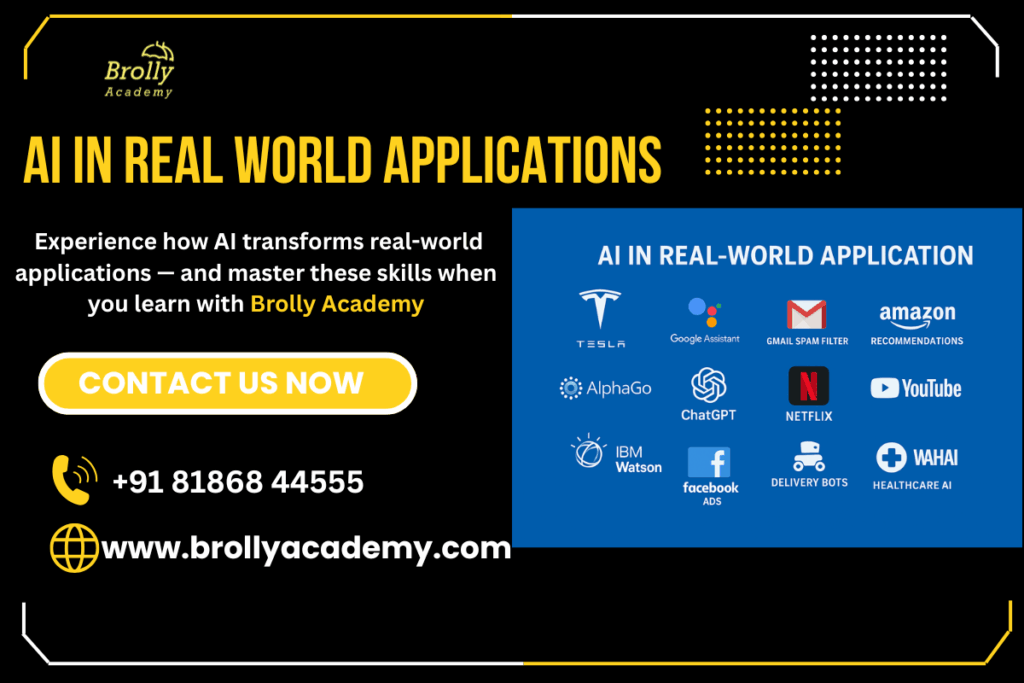
Benefits of Using Learning Agents in AI
- Learning agents in artificial intelligence are revolutionizing how systems think, act, and evolve.
- By continuously adapting through data and feedback, these agents bring remarkable efficiency and intelligence to modern technology.
Below are the key benefits of using adaptive AI systems and continuous learning models across industries:
1. Continuous Improvement
Learning agents constantly evolve by analyzing new data and experiences. This continuous learning process ensures that AI models become smarter, faster, and more accurate over time — improving overall performance without the need for complete retraining.
2. Adaptability
One of the greatest strengths of adaptive AI systems is their ability to adjust to changing environments, user behavior, and new situations. Whether in healthcare, finance, or robotics, learning agents quickly adapt to dynamic conditions to deliver reliable results.
3. Enhanced Decision-Making Accuracy
By leveraging large datasets and feedback loops, learning agents boost decision-making accuracy. They evaluate multiple possibilities before acting, ensuring optimized and data-driven outcomes across various AI applications.
4. Reduced Human Input
With AI automation benefits, learning agents minimize manual intervention by performing complex tasks independently. From self-driving vehicles to predictive analytics, these agents handle repetitive processes, freeing up human effort for strategic tasks.
5. Scalability and Efficiency
Learning agents can process vast amounts of information in real time, making them ideal for scaling operations in large organizations and autonomous AI systems. Their self-learning nature ensures faster, cost-effective, and intelligent decision-making.
Challenges in Designing Learning Agents
While learning agents in artificial intelligence offer tremendous potential, building them comes with several key challenges that impact AI model accuracy, performance, and trustworthiness.
1. Data Quality
Learning agents rely on high-quality data to make accurate predictions. Poor or biased data can reduce AI model accuracy, leading to unreliable or unfair outcomes.
2. Computational Cost
Training adaptive AI systems requires significant processing power and memory. Balancing performance with resource optimization remains a major design challenge.
3. Safety
In critical sectors like healthcare and autonomous driving, ensuring the safety of learning agents is vital. AI systems must make decisions without causing harm or failure in real-world environments.
4. Ethical AI Boundaries
Maintaining fairness, transparency, and accountability is essential. Ethical AI principles guide developers to prevent discrimination, data misuse, and unintended consequences in decision-making.
Key Features of Learning Agents
- Learning agents in artificial intelligence possess unique characteristics that enable them to operate intelligently and independently across complex environments.
These features drive autonomous decision-making and make adaptive AI systems more efficient and reliable.
1. Autonomy
Learning agents perform tasks and make decisions without constant human guidance. This autonomous decision-making allows them to act independently while continuously improving through experience.
2. Adaptability
A core trait of adaptive AI systems, adaptability enables agents to adjust to new data, environments, or user behaviors — ensuring consistent accuracy and performance even in changing conditions.
3. Rationality
Learning agents evaluate different options and choose actions that maximize success. Their rational decision-making process ensures logical, goal-oriented outcomes in both simple and complex scenarios.
4. Perception
Through sensors or data inputs, agents perceive their environment to make informed decisions. This ability enhances contextual understanding, crucial for tasks like image recognition or navigation.
5. Collaboration
Learning agents often interact and cooperate with other systems or agents to achieve shared goals. Such collaborative intelligence improves efficiency and supports collective problem-solving in multi-agent environments.
Top AI Tools & Libraries for Building Learning Agents
- Developing learning agents in artificial intelligence requires powerful AI tools and reinforcement learning frameworks that simplify model training, simulation, and deployment.
Below are some of the most popular platforms used by developers and researchers in 2025.
1. TensorFlow
TensorFlow is one of the most widely used AI tools for building and deploying adaptive AI systems. It provides a flexible ecosystem for neural networks, deep learning, and reinforcement learning models, making it ideal for scalable AI development.
2. PyTorch
Known for its simplicity and dynamic computation graph, PyTorch is a preferred choice for experimenting with learning agents. It supports advanced research in reinforcement learning frameworks and is extensively used for academic and industrial AI projects.
3. OpenAI Gym
OpenAI Gym is a benchmark platform for testing and training reinforcement learning agents. It provides a variety of environments — from simple games to complex simulations — allowing developers to measure and improve agent performance effectively.
4. Stable Baselines3
Built on top of PyTorch, Stable Baselines3 offers reliable implementations of popular reinforcement learning frameworks like PPO, DDPG, and A2C. It simplifies experimentation and fine-tuning of learning agents for both beginners and experts.
.

Real-World Applications of Learning Agents in AI
- Learning agents in artificial intelligence are transforming how industries function by enabling smarter, data-driven decisions and automation.
Below are some of the most impactful AI applications that demonstrate how adaptive AI examples are shaping the real world.
1. Tesla (Self-Driving AI)
Tesla uses learning agents to power its autonomous AI systems for self-driving cars. Through real-time data collection and reinforcement learning, the system continuously improves driving accuracy, safety, and decision-making — a perfect adaptive AI example in action.
2. Amazon (Adaptive Logistics)
Amazon’s logistics network relies on AI applications that use adaptive AI systems to predict demand, optimize delivery routes, and manage warehouse automation efficiently. The system learns from user behavior and logistics data to enhance speed and accuracy.
3. Google Search (User Intent Learning)
Google’s learning agents analyze massive amounts of search data to understand user intent. This AI application refines search rankings, personalizes content, and continuously adapts to how people phrase and seek information online.
4. Healthcare AI (Personalized Care)
In healthcare, adaptive AI examples include learning agents that analyze patient data to recommend personalized treatments. These systems improve diagnostic accuracy, predict risks, and support doctors with AI-driven decision-making for better outcomes.
Can Learning Agents Improve Without Human Help?
- Modern learning agents in artificial intelligence are designed to enhance their capabilities through self-learning AI mechanisms, allowing them to evolve without direct human intervention. These autonomous AI systems continuously gather data, analyze outcomes, and refine their models to achieve better accuracy, efficiency, and adaptability over time.
1. Self-Learning in AI
Self-learning AI refers to an agent’s ability to improve performance by learning from its own experiences instead of relying solely on human input. Through techniques like reinforcement learning and feedback loops, these agents independently recognize patterns, correct errors, and optimize decision-making. For instance, autonomous vehicles and chatbots learn from real-world data to handle new scenarios more intelligently.
2. Ethical Control in AI Systems
As autonomous AI grows more powerful, ensuring ethical behavior becomes essential. Ethical decision systems are integrated to monitor and guide learning agents, ensuring their actions align with human values, fairness, and safety standards. These systems prevent harmful biases, enforce accountability, and maintain transparency in AI-driven decisions.
Future of Learning Agents in Artificial Intelligence
- The future of learning agents looks incredibly promising as AI future trends continue to shape industries and research.
- These agents will become more autonomous, intelligent, and human-like — driving innovation across healthcare, robotics, education, and industrial automation.
Below are some areas where next-gen AI research is redefining possibilities.
1. Predictive Healthcare
In the coming years, learning agents will play a vital role in predictive healthcare, analyzing real-time patient data to forecast diseases before symptoms appear. Through next-gen AI research, doctors will gain proactive insights for personalized treatments, improving early diagnosis and patient care outcomes.
2. Space Robotics
AI future trends point to learning agents empowering space robotics to operate independently in extreme environments. These autonomous AI systems will navigate, repair, and make real-time decisions on distant planets — a major leap forward in next-gen AI research for space exploration.
3. Smart Factories
In smart factories, learning agents will drive adaptive AI systems that optimize production, predict equipment failures, and ensure seamless automation. This represents one of the strongest AI future trends, enhancing efficiency and sustainability in Industry 5.0 environments.
4. AI Education Systems
Learning agents in artificial intelligence will revolutionize education through AI-powered tutoring systems that adapt to each learner’s pace and style. Next-gen AI research will make learning more interactive, personalized, and accessible, empowering global education systems.
Real Brand Use Cases of Learning Agents in AI
- Several leading real-world AI brands have successfully integrated learning agents in artificial intelligence into their products and research, demonstrating how self-learning systems can transform industries.
- These learning agent case studies highlight how innovation, data, and automation come together in real business scenarios.
1. Google DeepMind
Google DeepMind is a pioneer among real-world AI brands, using learning agents to master complex challenges like AlphaGo, which defeated world champions through reinforcement learning. This learning agent case study showcases how AI can self-improve through experience and strategic decision-making — a breakthrough in next-gen AI research.
2. Tesla
Tesla’s autonomous AI systems rely heavily on learning agents for real-time decision-making in self-driving cars. By processing sensor data and continuously learning from millions of driving hours, Tesla represents one of the most practical learning agent case studies in adaptive driving technology.
3. IBM
IBM Watson, another key player in real-world AI brands, utilizes learning agents to enhance data analysis and predictive modeling. In industries like healthcare and finance, Watson demonstrates how intelligent systems can process vast information and assist in ethical, data-driven decisions.
4. OpenAI
OpenAI, the creator of ChatGPT, uses learning agents to advance conversational and generative AI. This learning agent case study illustrates how self-learning AI can understand context, refine responses, and learn from interactions — powering modern communication tools and virtual assistants.
Summary Box: Learning Agents in Artificial Intelligence
Here’s a quick recap of everything you need to know about learning agents in artificial intelligence, their working principles, benefits, and challenges — presented in a clear and easy-to-digest format
- What Learning Agents Are:
Learning agents are intelligent programs that can perceive their environment, learn from experience, and make autonomous decisions to improve over time. They form the foundation of adaptive AI systems that continuously evolve through data-driven insights. - How They Work:
A learning agent functions through four main components — the performance element, critic, learning element, and problem generator. Together, they enable observation, feedback processing, learning from outcomes, and exploration for better performance. - Key Tools:
Popular AI tools and reinforcement learning frameworks like TensorFlow, PyTorch, OpenAI Gym, and Stable Baselines3 help developers build, train, and test intelligent learning agents efficiently. - Benefits:
Learning agents bring continuous improvement, adaptability, and enhanced decision-making accuracy while reducing human intervention and optimizing AI automation benefits across industries. - Challenges:
Designing effective agents involves tackling issues like data quality, computational cost, safety, and ethical AI boundaries — all critical for maintaining trustworthy and efficient AI model accuracy.
FAQs
1. What is a learning agent in artificial intelligence?
A learning agent is an AI system that improves its performance through experience, adapting its actions based on feedback from the environment.
2. What are the main components of a learning agent?
The main components include a learning element, a critic, a performance element, and a problem generator — all working together to refine decisions.
3. Is reinforcement learning part of learning agents?
Yes, reinforcement learning helps agents learn from rewards and penalties, guiding them toward better decision-making.
4. Where are learning agents used in real-world applications?
They’re used in robotics, autonomous vehicles, gaming, and personalized recommendation systems
5. How do learning agents differ from reactive agents?
Reactive agents act on pre-defined rules, while learning agents evolve and adapt based on past outcomes
6. What is the role of the critic in a learning agent?
The critic evaluates performance and provides feedback that helps the learning element improve future actions.
7. How does the feedback loop work in AI learning agents?
It continuously monitors actions, compares them with desired outcomes, and updates the learning process.
8. Can a learning agent improve without human supervision?
Yes, through unsupervised or reinforcement learning methods, it can learn patterns without explicit labels.
9. What is the difference between supervised and reinforcement learning in AI?
Supervised learning uses labeled data, while reinforcement learning learns by interacting with an environment.
10. How do learning agents adapt to new environments?
They analyze changes, test new actions, and adjust strategies using feedback or rewards
11. What are some examples of learning agents in daily life?
Voice assistants, chatbots, and recommendation systems like Netflix or Spotify use learning agent principles.
12. How does a self-driving car use learning agents?
It learns from data on traffic, obstacles, and human behavior to make safe driving decisions.
13. What industries are adopting learning agents in 2025?
Healthcare, finance, manufacturing, and education sectors are integrating learning agents for automation.
14. What is the function of the problem generator in a learning agent?
It proposes exploratory actions that help the system discover new and better solutions.
15. How are AI learning agents used in robotics?
They enable robots to navigate, grasp objects, and perform tasks through trial and feedback
16. Are all intelligent agents learning agents?
No, some agents only follow pre-defined logic without learning from experience.
17. What makes a learning agent autonomous?
Its ability to learn, decide, and act without continuous external input defines autonomy.
18. How do learning agents use data to make better decisions?
They collect, process, and analyze data patterns to predict outcomes and choose optimal actions.
(Learning agents like these are often covered in AI courses at Brolly Academy.)
19. What are the challenges faced when designing a learning agent?
Challenges include handling noisy data, complex environments, and ensuring ethical decision-making
20. How are learning agents related to machine learning models?
They use machine learning algorithms to continuously enhance performance
21. What is the difference between goal-based agents and learning agents?
Goal-based agents aim to achieve specific objectives, while learning agents evolve to improve future performance.
22. Which algorithms are used to train learning agents?
Algorithms include Q-learning, deep reinforcement learning, and neural networks.
23. How does reinforcement learning help a learning agent improve performance?
It uses rewards and penalties to guide the agent toward more effective actions.
24. Can learning agents be used for predictive analytics?
Yes, they analyze data patterns to make accurate forecasts and decisions.
25. What are the advantages of using learning agents in AI systems?
They improve efficiency, adapt to change, and reduce human intervention over time.
26. How do companies like Google or Tesla use learning agents?
They apply them in self-driving technology, recommendation systems, and process optimization.
27. What are the ethical concerns related to autonomous learning agents?
Concerns include data privacy, accountability, and the risk of biased decision-making.
28. How do multi-agent systems interact with learning agents?
They communicate and collaborate to complete tasks efficiently through shared learning.
29. What tools or frameworks are used to build learning agents?
Popular tools include TensorFlow, PyTorch, and OpenAI Gym for simulation and training.
30. What is the future of learning agents in artificial intelligence?
Learning agents will drive next-gen automation, personalized systems, and intelligent decision-making.
(You can master learning agents and related AI concepts through expert-led training at Brolly Academy.).This is the furure of Learning agents in Artificial Intelligence.

